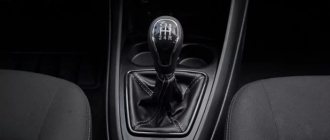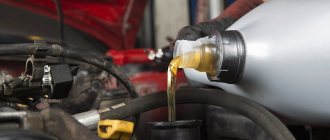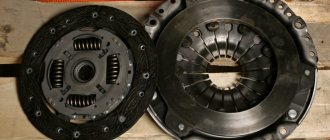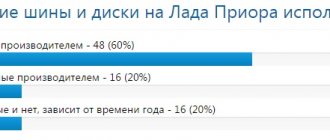Since 2015, a fundamentally new project of the AvtoVAZ concern called Lada Vesta has become available to Russian car enthusiasts. Considering the presentable appearance, modern powerful power units for this class with a volume of 1.6 or 1.8 liters, automatic transmission and other comfortable options, this vehicle has become the best-selling domestic car.
The plant’s engineers did not stop there; since the end of 2017, a unique modification of the brand has been released - the Lada Vesta SW Cross, which is a cross between a station wagon and a compact crossover and is a comfortable family car capable of driving on light off-road conditions in the winter.
Standard factory tires for Lada Vesta SW Cross
Choosing winter wheels for Lada Vesta SW Cross: comparing sizes and prices
What is the problem
The main reason for the agony of choice is the high cost of tires in their native size 205/50 R17: this is evidenced by reviews of the Lada Vesta SW Cross. Let's take, for example, the Finnish new Nokian Hakkapeliitta 9. In the factory standard size, one “cylinder” costs about 11,000 rubles. The average price of the same spike in size R15 is 5,500 rubles. Double savings.
To summarize, the cost of a set of 17-gauge tires is similar to the price tag for four 15-gauge tires already shod on alloy wheels. The configuration of the car allows for replacement - after all, the original spare wheel is made within the dimensions of 185/65 R15, and in reviews of the Lada Vesta SV Cross there is photographic evidence that the 15th disc does not touch the front brake calipers.
The gain in the initial price is complemented by another plus: the second set of wheels allows you not to go to the tire shop every season. Changing the shoes twice and balancing the 17th wheels will cost 3,000 rubles, which is not cheap. The third aspect is the smoothness of the ride: it is noticeably higher with decreasing rim diameter. With all these positive aspects, R15 tires look great in the arches of the Cross Vesta. Another thing is ground clearance... But here, too, catastrophic losses can be avoided.
Alternative size
When choosing tires of a different size, you can refer to the machine's operating manual. The table shows the recommended values for the standard station wagon version. The same options for winter tire sizes are also relevant for the Vesta SV Cross and the cross sedan:
However, owners of new cars prefer to partially deviate from these recommendations and use products of other sizes. Let's compare the performance data of various tires and enter them into the table.
| Standard size | Outer diameter, mm |
Difference with standard diameter, mm
For your information. The speedometer is calibrated to a circumference with a diameter of 637 mm. When installing a tire of a different size, it is necessary to introduce an error into the device readings. It will be minimal (0.5%) on 195/65 R15 tires.
Replacing disks
When switching to 15-gauge tires of a non-standard format, you will have to select car wheels using a calculator. However, the light alloy version for the 195/65 R15 tire has long been studied by Vestavod:
- Bolt pattern – 4x100.
- Reach – 43-45 mm.
- Width – 6J.
- The central hole is 60.1 mm.
The offset of the original 17-wheels is 43 mm. Experts allow fluctuations within 3-5 mm in a negative or positive direction.
For your information. It is permissible to select discs with a larger central hole diameter. Spacers are used to compensate for the difference. As a cheap alternative, you can consider used wheels from Nissan Almera, Renault Logan and Sandero.
Owners of Vesta SV Cross need to make a decision about choosing winter tires of a different size consciously. The instruction manual allows only 205/50 R17 to be used in this version. Installing a different standard size may cause contradictions of the following nature:
- Loss of warranty (maybe not - discussed with the official dealer).
- Refusal of insurance payments in accordance with current legislation.
- Inability to register a vehicle because changes have been made to the design of the vehicle.
Advantages and disadvantages
For 15 disks, the advantages are:
- Price (the set is 9,000 rubles cheaper).
- The car drives smoother.
- The wheels are practical, easier to find in a store.
- It's harder to get a side cut.
- Less chance of denting discs.
With 16 wheels, the Lada Vesta looks more beautiful and handles better. As a result, I settled on size 15 - 195/65 R15. In this size, the outer diameter, compared to stock wheels, is 13 mm larger. The wheel arch is filled out more, but the wheel appears visually smaller. The ground clearance rises by 6.5 mm.
This option is also suitable for the Cross package. The difference in outer diameter with standard tires is only 2 mm.
I was worried that the front wheels would hit when turning. Therefore, I bought wheels with an offset of not 50, but 45 mm. This does not affect anything, and for the Cross the offset is generally 43 mm.
Verdict
Changing your Lada Westa SW Cross to winter tires is not cheap. The total cost of tires and tire fitting is at least 23,000 rubles. For this money, the factory 205/50 R15 wheels will have the Kumho WinterCraft ice Wi31 middle class stud. The alternative is to break the law: then for the same amount you can get good 195/65 R15 tires and alloy wheels.
Uncompromising tires – Nokian Hakkapeliitta 9, R3 and Continental ContiIceContact 2 and ContiVikingContact 6. Significant costs are justified by reasonable behavior on any surface. Among Velcro, the popular choice is Nokian Nordman RS2. The optimal studded tire is Nordman 5, 7.
Reading time: 7 minutes
Since 2015, a fundamentally new project of the AvtoVAZ concern called Lada Vesta has become available to Russian car enthusiasts. Considering the presentable appearance, modern powerful power units for this class with a volume of 1.6 or 1.8 liters, automatic transmission and other comfortable options, this vehicle has become the best-selling domestic car.
The plant’s engineers did not stop there; since the end of 2017, a unique modification of the brand has been released - the Lada Vesta SW Cross, which is a cross between a station wagon and a compact crossover and is a comfortable family car capable of driving on light off-road conditions in the winter.
Standard factory tires for Lada Vesta SW Cross
Winter tires on SW Cross
The developers tried to achieve a crossover effect from the standard wheelbase of this car. Winter tires on the Lada Vesta SV Cross can only be installed in 17-inch sizes, since these are the wheels that allow you to achieve a maximum ground clearance of 203 mm. The SV Cross modifications are coming off the assembly lines of automakers, having the following basic characteristics of tires installed in the standard version only for use in the summer:
- If we consider only geometric parameters, then the wheels for this modification of the Lada have the same size - 205/50/R17, which allows the car to have a decent appearance, overcome difficult sections of the road, and also not get stuck on soft ground thanks to the wide sole with powerful treads.
- When choosing winter tires for the Lada Vesta SW Cross, drivers should remember that most of these wheels are produced in an all-season version. If they need to choose a good friction or studded tire, they should still change the wheel to R16, since a 55-60 mm side cord is much more reliable when driving on rough terrain in the cold season.
- When a driver operates his car exclusively in a big city, he may well use all-season tires.
- Vesta Cross tire sizes do not offer drivers a rich assortment due to the specific technical characteristics of the vehicle. Absolutely all tires installed as standard on this modification of Vesta have special indexes.
On the profile of the Vesta SV Cross tire you can find the abbreviation M + S, which means Mud and Snow, and translated into Russian - “dirt” and “snow”. This designation does not mean that the tire has excellent grip on the road surface at temperatures below 0 degrees Celsius, but the treads are designed in such a way that the tire has traction properties on almost any surface down to -10 degrees.
Winter tires for Lada Vesta SW Cross
- The last important point when choosing tires for a given car is the shi indices. Considering the model’s ability to overcome areas with poor road quality, as well as the ability to accelerate to a speed of 190 km/h, these parameters in the factory version vary from 89V to 93W. These figures mean that when inflated, each wheel can withstand a load of up to 580-650 kg, and you can safely drive in this state at a speed of 240-270 km/h for at least 30 minutes without the risk of dismantling.
Standard sizes
The main goal of the developers of LADA Vesta SW CROSS was to create a car with increased ground clearance. From the factory, this car is produced only on 17-inch wheels. Thanks to this, the car's ground clearance is an incredible 203 mm.
LADA Vesta SW CROSS
The only basic tire size is 205/50/R17. This is enough to give the car:
- attractive appearance;
- excellent cross-country ability;
- ability to overcome light off-road conditions.
All this is achieved due to the wide contact of the tire. If you are looking for winter tires for the LADA Vesta SW CROSS, you should know that most options will be all-season.
If you want to give your car excellent cross-country ability in difficult winter conditions, a better decision would be to opt for R16 studded tires with a profile height of 55-60%. This will allow you to move comfortably over rough terrain.
Studded tires size R16
If the car is used exclusively in city conditions, then the size of winter tires on the Lada Vesta SV Cross can be left as standard. Its performance indicators will be enough to make you feel comfortable driving a domestic crossover.
How to choose the right winter tires for Lada Vesta SW Cross
- If the driver drives his Lada exclusively in the city, then the all-season M + S version with hard treads that will not wear out quickly during sharp braking or when turning on asphalt surfaces will suit him.
- When the vehicle is operated on country roads, or in the region where the driver lives, the air temperature often drops below -10 degrees Celsius, then it is simply impossible to do without full-fledged winter tires. And it’s even better if it is equipped with multi-directional metal spikes, which will ensure the stability of the car during acceleration, braking and cornering.
- If the car is planned to be used on rough terrain with completely snowy roads, then a studded tire will be unnecessary, because the studs play virtually no role in traction, and the main function is taken over by the soft tread. Thus, a car enthusiast should purchase a friction tire, the surface of which is cut into numerous lamellas with sharp edges.
Friction tires on Lada Vesta SW Cross
These elements, when pressed on them under the weight of the car, move apart, forming dozens of cracks, into each of which the snow mass falls, lingering there for a certain time.
If excess moisture forms under the wheels (for example, at zero temperature outside the window, when the snow turns into mush), then it is effectively removed through special grooves for collecting water between the blocks of lamellas.
- When choosing wheels, a car enthusiast can turn not only to companies that are authorized brands of the concern, but also to other brands whose products are adapted for normal use in the middle zone. This means that the chemical composition of the rubber must be selected in such a way that the protectors do not harden even at extremely low temperatures.
What other tire parameters are recommended for the Lada Vesta Cross?
In addition to the listed characteristics, this model represents a technological breakthrough in the long history of the Lada brand. These adjustments relative to the classic modifications could not but affect the characteristics of the wheels, which have the following distinctive features:
- The recommended wheels for Vesta SV Cross in size 17 are at odds with the understanding of budget tires for the Russian consumer. The wheel rim parameters for this modification are 6.5J x 17 ET43 - this is a very rare size to find a worthy replacement.
- Installing tires with a diameter of 16 inches with a complete replacement of wheels will cost almost the same as purchasing new tires with a mounting diameter of R17. At the same time, having assembled wheels in the garage will allow the car enthusiast to save money and time on tire fitting for 4-5 seasons in a row, which will fully cover the costs. If you already have carefully balanced wheels, the car enthusiast can do this procedure independently, having with him only a wheel wrench and a compressor with a pressure gauge for inflating the tires.
Alloy wheel KiK 6J x 16 ET41
- Experts, recommending the installation of rubber of a smaller size than factory products, explain the successful choice by the fact that the high profile (up to 60 mm) ensures traction of the rubber along the side cord, and not just along the sole. In this case, the cylinder contains an increased air buffer, which completely absorbs all shock and vibration loads on the wheel already in the suspension part of the vehicle. This technical solution helps to increase the service life of the vehicle, as well as its main systems - brakes, hubs, bearings, suspension and steering rods.
Considering that any gas compresses when the thermometer drops, it is better to keep the pressure indicators for such rubber at 2.4 atm. In this case, when driving, rolling resistance will practically not interfere with developing the required speed, which will lead to significant fuel savings.
The wheel size of the Lada Vesta SV Cross does not have to be kept exactly in accordance with the recommended parameters, paying attention only to the disc offset. These changes will allow us to completely maintain the point of load application to the hub in accordance with the design parameters. At the same time, this will increase the comfort and safety of the driver, as well as his passengers, and save the driver’s budget. After all, tires in smaller sizes are more accessible both in purchase and during installation work.
The start of sales of the Lada Vesta SV Cross all-terrain station wagon was given about a year ago. The new product of the domestic automobile industry turned out to be quite successful in sales. This is facilitated by a fresh design and good build quality. In addition to this station wagon, the AvtoVAZ line, as you've probably heard about, includes the Vesta sedan models (regular and cross versions) and the Vesta SV city station wagon. A characteristic difference between the SV Cross station wagon and other models is the installation of large wheels with a diameter of 17 inches. In this article, we suggest delving into the topic of wheels and answering basic questions about choosing tires for the Lada Vesta SV Cross.
Experienced car owners know that tires are an important component in the operation of the car. The choice of tires affects many parameters, including handling, braking distance, fuel consumption, vehicle acceleration dynamics and road stability. In addition, well-selected tires reduce driving noise and reduce the wear and tear of your vehicle's suspension. As you can see, the choice of car tires for the Lada Vesta SV Cross, as well as for any other car, must be approached very responsibly.
Installing larger diameter discs
Large rims not only change the appearance of the car, but also affect its dynamics, maneuverability, and stability on the highway, and not always for the better.
17-inch wheels were installed on the Concept version of the Lada Vesta. Technically, this sedan can also be equipped with R18 wheels, but the outer diameter of this wheel (669 mm), as well as the tire width (235 mm), differ significantly from the factory values and cannot be considered in the real conditions of Russian roads due to the too low profile as practical - defects in the road surface will quickly damage both tires and wheels, the price of which, due to their size, is several times higher than the cost of standard ones.
- increasing the style of the car and the effectiveness of the exterior;
- improvement of driving qualities - dynamics, road stability, steering sensitivity;
- better “absorption” of potholes compared to a smaller radius;
- with a tire profile from 55 – increased durability of the suspension;
- reducing the braking distance;
- increasing the efficiency of ABS and ESP.
- uncomfortable driving due to sensitivity to road surface defects;
- restriction of use on roads with defective surfaces;
- the need for increased pressure control;
- greater need for kinetic energy at the start - higher fuel consumption;
- higher cost.
This parameter, ignored by novice car enthusiasts, is very important when operating cars with any tires, and especially with low-profile ones. The required tire pressure is always indicated by the vehicle manufacturer in the operating instructions and in an accessible place on the body, for the Lada Vesta - on the B pillar on the driver's side.
Low profile tires require increased attention to pressure, as insufficient pressure will make the wheels and suspension even more vulnerable to potholes and rocks on the road.
As many years of experience have shown, the pressure in low-profile tires must be maintained 15% higher than that specified by the manufacturer for wheels of the recommended size.
Typical tire size
So, to better understand the type of tires, let's look at the table that shows the main indicators. After carefully studying the data, the choice of tires for the Vesta SV Cross with the following parameters becomes obvious: 205/50 R17.
In fact, AvtoVAZ recommends using these. Moreover, this type of rubber may have different load capacity and speed indices.
If the owner installs wheels that require a slightly different type of tire, it is permissible to use slightly wider (215) and narrower (195) tires. The table below shows typical options for wheels and tires that can be installed on the Lada Vesta SV Cross.
| 205/55 R16 | 632 | Cost in size 195/65 R15, rubles | 5 500 | 11 000 |
| 3 000 | – | 7 000 | ||
| 4 800 | 3 500 | 7 300 | ||
| 2 800 | 3 000 | 6 200 | ||
| 3 100 | 3 600 | 6 600 | ||
| 3 000 | 3 200 | 6 100 | ||
| 3 300 | 3 800 | – | ||
| 3 200 | 4 100 | Cost in size 195/65 R15, rubles | ||
| Nokian Hakkapeliitta R3 | ||||
| Nokian Nordman RS2 | ||||
| Continental ContiViking Contact 6 | ||||
| Goodyear UlrtaGrip Ice 2 | ||||
| Cordiant Winter Drive PW-1 | ||||
| Dunlop Winter Maxx | ||||
| Toyo Observe GSi-5 | ||||
| Gislaved Soft Frost 200 | ||||
| Hankook Winter i*Cept IZ2 | ||||
| Kumho I'ZEN KW31 | ||||
| Bridgestone Blizzak VRX | ||||
| Pirelli Ice Zero FR | ||||
| Yokohama W.drive |
From the table we can draw a simple conclusion: if you need higher tires, you need to install wheels of a smaller diameter. So, to install the highest (65) tires, you will need 15-inch wheels.
Video review of tires on Lada Vesta SV Cross:
A few final words
Thus, tires for the Lada Vesta SV Cross are somewhat different from most tires in recent car models from the AvtoVAZ brand, which is due to the increased diameter of the wheels (17 inches). It is worth noting that there are now many different tire models available, which differ in their performance and cost.
In any case, it is advisable to choose those options that meet the requirements of automakers, and also not to save money. It is better to buy tires in trusted auto stores - this way you can be as confident as possible in the reliability and durability of the purchased elements.
Next is an interesting decision about what tires to put on your Lada Vesta SV Cross for the winter:
Decoding tire markings
However, not everyone finds it easy to understand the large number of parameters with which tires are marked.
As a rule, when choosing tires, buyers focus only on the diameter, width of the rubber profile and height, after which the speed and load capacity index are selected.
Now let’s look at what this or that inscription on car tires means. Let's do this using the example of a tire marked 195/65 R15 91 T XL. In this case, the manufacturer and the specific model are not important, we are only interested in the marking itself.
The first number in the marking always indicates the width of the tire in millimeters. The sample in question has a diameter of 195 mm.
The next number is the tire height. 65 is the percentage of height to width. With simple steps we get approximately 127 mm (65% of 195).
Next comes the English letter R. Contrary to the opinions of many car owners, it does not mean the size, that is, the radius, of the tire, but denotes the tire manufacturing technology. R - radial cord. All types of tires for cars are produced using this technology.
To be fair, it is worth noting one more meaning of the designation of the letter R, but not independently, but in tandem with the number following it (in the example - 15). This marking indicates the inner diameter of the tire and, accordingly, the diameter of the rim to which it fits.
What tire pressure is needed for Vesta SV Cross
Well, we’ve sorted out the wheel markings, let’s move on to such an important parameter as pressure. Pressure is measured in atmospheres and factors such as:
- vehicle handling;
- comfort when moving;
- tire durability;
- disk integrity.
Too high tire pressure when driving, especially on rough roads, will lead to early tire failure due to wear of the tread in the central part of the wheel.
At the same time, low pressure will ensure a smooth and soft ride of the car. However, a car with such wheels is less controllable at high speed. In addition, there is a possibility of increased tire wear along the edges of the wheel. The rims of your car may also be damaged.
When driving into a hole, tires with low pressure will not be able to provide the necessary protection, which may cause part of the disk to bend.
What tire pressure should I choose for the Lada Vesta SV Cross? Recommended values are 2.1 - 2.5 atmospheres. The pressure is selected based on the driving style and the required driving comfort. However, you should not go beyond the recommended parameters.
Pressure recommendations for winter
A very important indicator for tires is pressure. It is this parameter that affects the following characteristics:
- car controllability;
- comfort of movement;
- safety of rubber and duration of its operation.
Too high tire pressure will create discomfort when driving over uneven surfaces, and will also lead to increased wear of the tread pattern in the center of the wheel.
It is important to monitor tire pressure while driving the vehicle.
The most optimal pressure for tires installed on LADA Vesta SW CROSS is 2.1 – 2.5 atm. It all depends on the chosen driving style, as well as comfort requirements. It is not advisable to overinflate the wheels and vice versa.
Choosing tires for Lada Vesta Cross
For the most correct and accurate choice of tires for the Lada Vesta Cross, it is worth considering the conditions in which the car will be used most of the time. If you live in a city and plan to drive exclusively on good, smooth roads, you can install low-profile tires. If you need to travel outside the city or often get out into nature, you should give preference to a higher profile. This way the car will have greater driving comfort.
In addition to the height of the rubber profile, comfort is also affected by the noise emanating from the rubber when driving. To achieve less noise, you need to buy softer tires. And, of course, it’s worth choosing the right tread type. There are mainly four types available for sale:
- symmetrical directional;
- symmetrical non-directional;
- asymmetrical non-directional;
- asymmetrical directional.
Let's look at each type in more detail.
Symmetrical directional
Tires with this type of tread are suitable for those who like to drive fast. The advantage of this type is its resistance to aquaplaning, since the tread perfectly drains water when entering the water. The disadvantage of these tires is considered to be increased noise.
Symmetrical omnidirectional
This type of tire is distinguished by its versatility. Yes, tires with such a tread do not drain water so well, but they are suitable for drivers who prefer normal driving speeds. The advantage of tires with a symmetrically directed tread is that a car equipped with them behaves confidently both on gravel and on asphalt roads.
Asymmetrical omnidirectional
A closer look at tires with asymmetrical non-directional treads will reveal that they have a stiffer outer portion. Due to this, such rubber has increased resistance to damage. At the same time, the inside of these tires is responsible for draining water. The central part of the tire is designed for overall stability. Of course, the stiffer parts provide obvious advantages, but they are also responsible for a significant disadvantage of these tires.
Due to its increased rigidity, this type of rubber extremely weakly absorbs vibrations when driving.
Asymmetrical directional
The least common tire option. This type has been discontinued. The main feature of this rubber was increased drainage with smooth load distribution. But its main drawback was the need to have 2 spare wheels at once. If something happens to a wheel, you need to change a couple of wheels at once, which, you see, is extremely inconvenient.
After familiarizing yourself with each type of rubber, you can make your choice. Yes, it is difficult to choose the ideal tires for your car, since each of the types listed has both obvious advantages and undeniable disadvantages. When choosing, you should rely on your driving style, climate and conditions of use of the car.
Should AVTOVAZ be blamed?
First of all, the wording “it turned out” in the reader’s question is unclear. The dimensions of tires and wheels allowed by the manufacturer are indicated in the operating instructions, which are posted on the official website in the public domain.
If spending on consumables for a car is so important for the future owner, it is advisable to conduct a price analysis before purchasing the car
It is worth admitting that with the price of the original 17-inch wheel (about 7,500 rubles), AVTOVAZ was really greedy. After scouring a dozen of the largest wheel sales sites, I really only found one perfect option - the KiK Flanker. It is cheaper by a thousand rubles, which saves 4,000 rubles per set. Which, in my opinion, is not so little.
After all, there is no obligation to necessarily start a complete winter kit. Are the wheels too expensive? Buy only tires. For the money that a Lada dealer asks for one disc, you can change the shoes of the entire car three or four times.
And to be completely honest, AVTOVAZ is by no means alone in the desire to make a little money. If you look for it, a similar “scam” for extra money can be found in almost any car! And the case with Vesta Cross is not the worst: for an attentive buyer it is obvious even before purchase.
Without going too far from the topic of the chassis, two examples come to mind off the top of my head. For a long time, French cars used light alloy wheels without a center hole. It is impossible to balance them on a standard tire machine. I had to look for a workshop with rare equipment. To someone in the regions - I'm sure! — there was only one way, to the official dealer with its queues and draconian prices. And for Citroen’s proprietary Hydractive suspension, non-original struts were not produced. And this despite the fact that on the last generation C5, their “snotty” and knocking could not be corrected for years, and the owners of the cars changed several sets in a row.
Finally, a little tip: write complaints and suggestions if you are not satisfied with something. Just not to the magazine “Behind the Wheel”, but directly to the manufacturer. In recent years, AVTOVAZ has demonstrated more than once that it listens to customers. Perhaps, when the number of requests reaches a critical volume, 16-inch tires and wheels will be certified for Vesta in the Cross version.
The list of the main characteristics of the car also includes the tire size, since this parameter is not only an element of the exterior, but also a factor influencing the handling, dynamics and cross-country ability of the car. Let's consider the size of the wheels of the Lada Vesta sedan, which is increasingly found on the roads.
Winter tires for Lada Vesta Cross
If you need winter tires for your Lada Vesta Cross, you should contact one of the many online stores where you can specify the wheel parameters you need and all you have to do is choose. The easiest way is to go to Yandex.Market, open the Auto category and select Tires. In the parameters, enter 205/50 R17 if you are using standard wheels, or any other value for your wheels.
In addition, you can select the “Discounts and promotions” category and save on your purchase. As a result, we get a lot of options from various manufacturers in the price range from 2,500 to 18,700 rubles per wheel. Among them there are both friction and studded types of rubber. Which one is preferable is up to you to decide, based on your available budget and personal preferences.
Remember that high-quality tires, if used correctly, will serve you for several seasons and will ensure a comfortable ride and safety on the road.
| Acceptable tire and wheel options | |
| Tires | Discs |
| 195/65 R15 | 6.0Jx15 ET37 |
| 205/55 R16 | 6.0Jx16ET40 |
| 205/50 R17 | 6.5Jx17 ET41 |
| 205/45 R18 | 7.0Jx18 ET38 |
| 215/45 R17 | 7.0Jx17 ET38 |
| 215/40 R18 | 7.0Jx18 ET38 |
How much money is needed
I had 30 thousand rubles, went shopping, compared prices.
In neighboring stores, the price per set may differ by 6-8 thousand. For example, I found Michelin tires for the Lada Vesta in the cheapest store that cost 3,950 rubles. The most expensive one costs 4,900 rubles. “SKAD” wheels: cheap – 4000, expensive – 4500.
The kit could be bought for 32 thousand, and exactly the same one in another store for 38. This is provided that the diameter is R15. If we compare 16 wheels, I couldn’t find Michelin 195/55 R16 tires; other options start from 5,500 rubles. The closest size to the factory one is 195/60 R16, but the price tag for it is too high - from 6800 rubles.
A larger tire 205/55 R16 costs from 5,500 rubles - a difference of 1,300. The price for 16 SKAD wheels is 5,000 rubles, a set with tires costs about 42 thousand.











